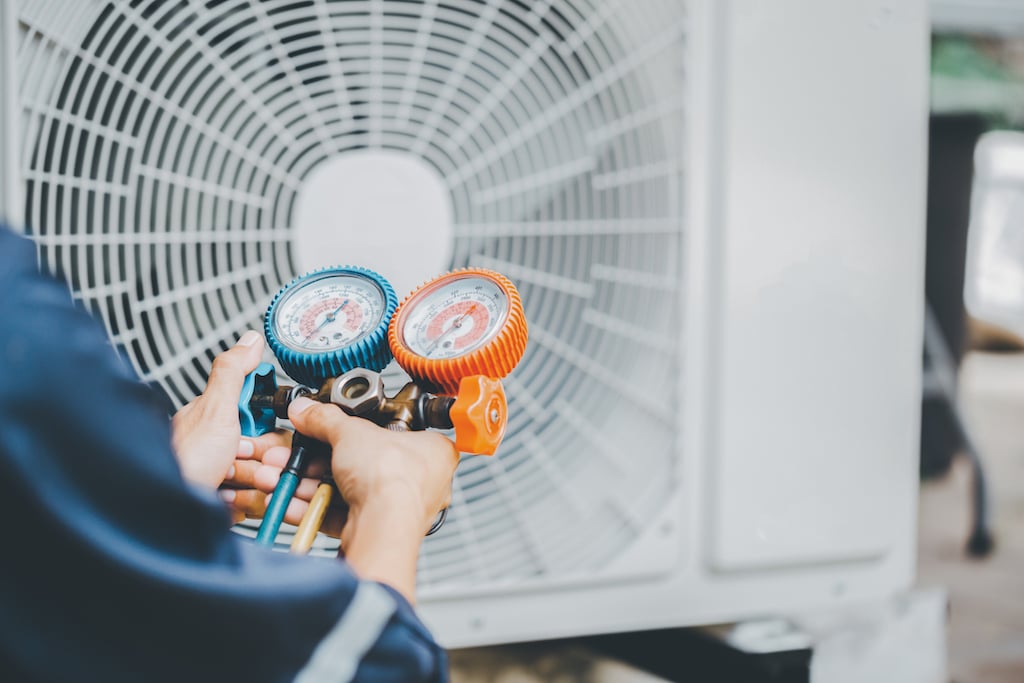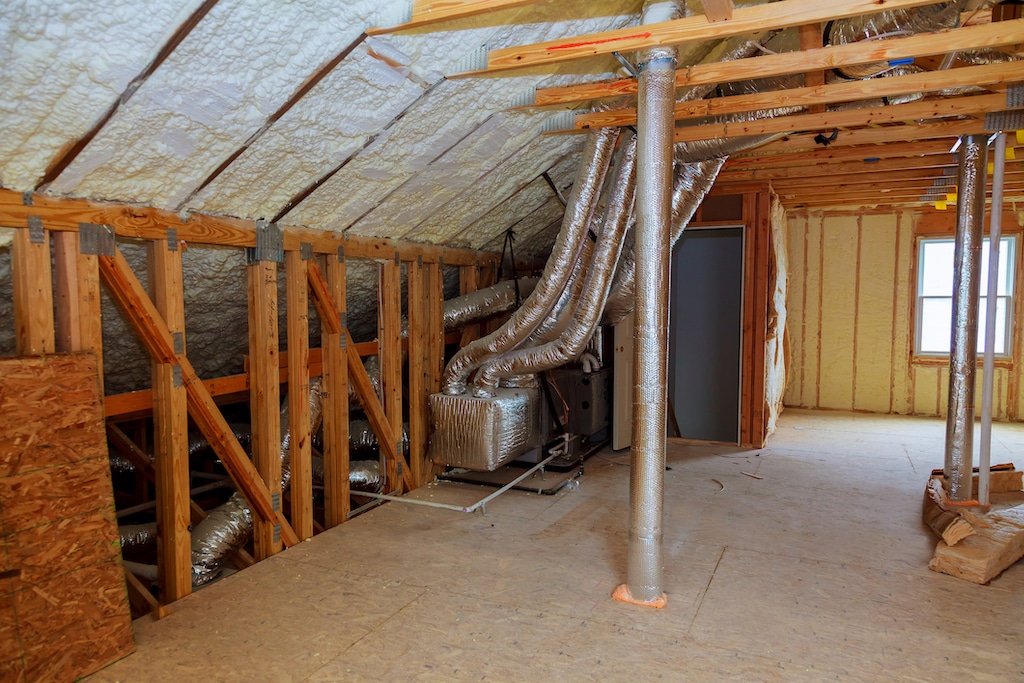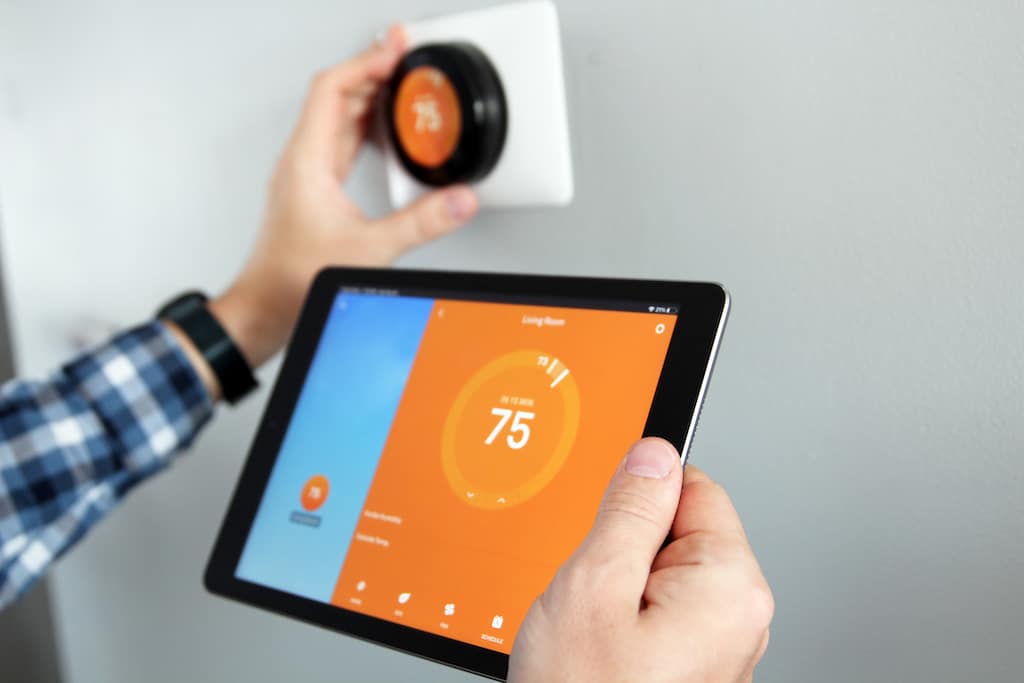
Unlock Comfort: Essential Guide to Residential HVAC System Components
Have you ever wondered what keeps your home so comfortable, regardless of the weather outside?
The answer lies in the sophisticated workings of your residential HVAC system.
This system is your unsung hero, working tirelessly to ensure your living space remains a haven of comfort.
But what makes up this essential home system?
In this article, we delve into the heart of your home’s comfort—the residential HVAC system components.
We’ll explore each part’s role, how they work together, and why understanding them is crucial for homeowners. From ensuring efficient operation to troubleshooting common issues, this guide will provide you with a comprehensive understanding of your HVAC system.

Photo By Kunakorn Rassadornyindee at iStock
What are Residential HVAC System Components?
Residential HVAC system components are the essential parts that form the backbone of your home’s heating, ventilation, and air conditioning (HVAC) system.
This system plays a pivotal role in ensuring your living space remains comfortable, regardless of the weather conditions outside. The main components of a residential HVAC system include the thermostat, which acts as the control center allowing you to set and adjust your home’s temperature to your liking.
The air handler circulates air throughout your home, working in conjunction with the heating and cooling elements to adjust the air temperature as needed.
Heating and cooling elements are critical for changing the air temperature to your desired setting, ensuring your home remains warm during cold winters and cool during hot summers.
The ductwork in your home serves as the network of pathways that distribute the conditioned air throughout various rooms, ensuring an even temperature is maintained across different spaces.
Vents are strategically placed in rooms to allow the conditioned air to enter, while filters clean the air as it circulates through the system, removing dust, pollen, and other airborne pollutants, thus improving your home’s air quality.
Understanding the parts of a residential HVAC system and their respective roles is crucial for homeowners. Not only does it empower you with the knowledge to maintain a more efficient and effective system, but it also helps in identifying common issues that may arise.
Regular maintenance of these components can prevent breakdowns, extend the lifespan of your HVAC system, and ensure it runs at peak efficiency, ultimately saving you money on energy bills and costly repairs.
By familiarizing yourself with these components, you can ensure a comfortable, healthy, and energy-efficient living environment for you and your family.
Also read: Mastering The World Of Heating And Ac Repair: A Comprehensive Guide
A Detailed Explanation of Residential HVAC System Components
The residential HVAC system is a complex network of components working in harmony to regulate your home’s temperature, humidity, and air quality. Here’s a closer look at these residential HVAC system components:
Thermostat: The Heart of Your HVAC System
The thermostat (one of the residential HVAC system components) acts as the brain of your residential HVAC system, a crucial component that homeowners interact with daily.
It’s the interface that allows you to control the climate within your home, setting the stage for a comfortable living environment.
By adjusting the thermostat, you dictate the temperature settings for both heating and cooling, making it an indispensable tool for achieving optimal comfort levels.
Types of Thermostats
There are several types of thermostats available, each with its own set of features and capabilities.
Traditional thermostats offer basic functions, allowing you to manually set the temperature. Programmable thermostats, on the other hand, provide the ability to set different temperatures for various times of the day or week, offering a blend of convenience and energy efficiency.
Smart thermostats take this a step further by learning your habits and adjusting the settings automatically, in addition to being controllable via smartphone apps. This evolution in thermostat technology not only enhances user experience but also contributes to significant energy savings.
The Role of the Thermostat in Energy Efficiency
The thermostat plays a pivotal role in the energy efficiency of your residential HVAC system. By accurately setting and adjusting the temperature, you can ensure that your HVAC system is not overworking, thereby reducing unnecessary energy consumption.
Programmable and smart thermostats are particularly effective in this regard, as they can adjust the temperature based on your schedule, ensuring that the system is only in use when needed.
This not only helps in maintaining a comfortable temperature but also in reducing your home’s overall energy footprint.
Air Handler: The Circulatory System of Your HVAC
The air handler (one of the residential HVAC system components) serves as the heart that pumps air throughout your home.
This crucial piece of equipment works in tandem with the heating and cooling elements to ensure that air is efficiently distributed to every corner of your living space. Understanding the role and functionality of the air handler can significantly enhance your home’s comfort levels and the overall efficiency of your HVAC system.
Components of the Air Handler
The air handler comprises several key parts, each playing a vital role in air circulation:
Blower Motor
This is the driving force that propels air through the ductwork. Depending on the model, blower motors can have variable speeds to adjust airflow based on the system’s needs, contributing to the system’s overall efficiency and comfort levels.
Coils
In conjunction with the heating and cooling elements, the coils in the air handler either heat or cool the air as it passes through. The efficiency of these coils directly impacts the effectiveness of your HVAC system in temperature regulation.
Air Filters
Positioned within the air handler, these filters trap dust, pollen, and other airborne particles, ensuring that the air distributed throughout your home is clean.
Regular maintenance of these filters is crucial for maintaining air quality and the efficient operation of your HVAC system.
The Importance of the Air Handler in HVAC Efficiency
The efficiency of your residential HVAC system heavily relies on the proper functioning of the air handler.
A well-maintained air handler ensures optimal airflow, which is essential for maintaining desired temperature levels throughout your home. It also plays a critical role in air filtration, improving indoor air quality by removing contaminants from the air before it circulates through your living spaces.
Maintaining Your Air Handler
Regular maintenance of the air handler is essential for the longevity and efficiency of your HVAC system.
This includes periodic checks and cleaning of the blower motor, coils, and replacing air filters regularly. Ensuring that these residential HVAC system components are in good working condition can prevent common HVAC issues, reduce energy consumption, and extend the life of your system.
The air handler is more than just a component; it’s the lifeline of your residential HVAC system, ensuring that heated or cooled air is effectively circulated throughout your home.
By understanding its role and maintaining its residential HVAC system components, you can enjoy a more comfortable, efficient, and healthy living environment.
Regular maintenance and awareness of the air handler’s function within the HVAC system can lead to significant improvements in system performance and energy savings.
Heating and Cooling Elements: The Core of Comfort
The heating and cooling elements within your residential HVAC system are fundamental components that directly influence your home’s temperature and overall comfort.
These elements are tasked with altering the air temperature to match your desired settings, ensuring your living environment remains pleasant throughout the year. Understanding how these components work can provide insights into the efficiency and functionality of your HVAC system.
Heating Elements Explained
The heating (one of the residential HVAC system components) can come in various forms, including furnaces that use gas, oil, or electricity to generate heat.
Electric heat pumps can also serve as both heating and cooling solutions, drawing heat from the outside air or ground to warm your home during colder months.
The efficiency of these heating elements is measured by their ability to convert energy into heat, impacting your home’s energy consumption and heating costs.
Furnaces: Utilize a heat exchanger to warm the air, which is then circulated by the air handler.
Heat Pumps: Work by transferring heat from one area to another, efficient for both heating and cooling.
Cooling Elements Explained
For cooling, central air conditioners and heat pumps are commonly used in residential settings. These systems use refrigerant to absorb heat from indoor air and release it outside, effectively lowering the temperature inside your home.
The key residential HVAC system components of the cooling system include the evaporator coil, which cools the air, and the condenser unit, which expels the heat outdoors.
Central Air Conditioners: Comprise an outdoor unit (condenser) and an indoor unit (evaporator coil) working together to cool your home.
Heat Pumps: In cooling mode, operate similarly to air conditioners but with the added benefit of reversing the process for heating.
The Role of Heating and Cooling Elements in HVAC Efficiency
The efficiency of your HVAC system heavily relies on the proper functioning and maintenance of the heating and cooling elements.
Advances in technology have led to more energy-efficient solutions, such as variable speed heat pumps and high-efficiency furnaces, which can significantly reduce energy consumption and lower utility bills.
Regular maintenance, including cleaning and servicing of these elements, ensures they operate at peak efficiency, extending their lifespan and maintaining consistent comfort levels in your home.
The heating and cooling elements are the backbone of your residential HVAC system components, providing the necessary adjustments to air temperature that keep your home comfortable year-round.
By understanding these components and ensuring they are well-maintained, you can enhance the efficiency of your residential HVAC system components, reduce energy costs, and enjoy a comfortable living environment regardless of the season.

Photo By photovs at iStock
Ductwork: The Vascular System of Your HVAC
Ductwork (one of the residential HVAC system components) plays a crucial role in your residential HVAC system, acting as the vascular system that distributes conditioned air throughout your home and returns it to the HVAC system for reconditioning.
This network of tubes is essential for delivering comfort to every room, ensuring that heated or cooled air reaches its intended destinations efficiently.
Understanding the structure and function of ductwork can significantly impact the overall performance of your HVAC system and your home’s comfort levels.
Components of Ductwork
The ductwork system is composed of several key residential HVAC system components components, each serving a specific function:
Supply Ducts: These are responsible for transporting conditioned air from the HVAC system into the various rooms of your home.
Return Ducts: They draw air from within your home back to the HVAC system for reheating or recooling, maintaining a constant air circulation.
Vents: Positioned at the end of supply ducts, vents allow the conditioned air to enter the living spaces. Similarly, return vents draw air back into the return ducts.
Insulation: Many duct systems are insulated to prevent heat loss or gain as air travels through unconditioned spaces, such as attics or crawl spaces, enhancing the system’s efficiency.
The Importance of Proper Ductwork Design
The design and installation of ductwork significantly influence the efficiency and effectiveness of your HVAC system.
Properly sized and strategically placed ducts ensure even distribution of air, eliminating hot or cold spots in your home. Additionally, well-sealed and insulated ductwork minimizes energy loss, reducing heating and cooling costs and leading to a more environmentally friendly home.
Maintaining Your Ductwork
Regular maintenance of your ductwork is essential for the longevity and efficiency of your residential HVAC system components. This includes checking for leaks, blockages, and ensuring that ducts are properly sealed and insulated.
Leaky or poorly insulated ducts can lead to significant energy loss, undermining the efficiency of your HVAC system and resulting in higher utility bills.
Professional duct cleaning can also remove dust and debris, improving indoor air quality and system performance.
Ductwork (one of the residential HVAC system components) ensures that conditioned air is efficiently distributed throughout your home.
Proper design, installation, and maintenance of ductwork are crucial for maximizing comfort, enhancing system efficiency, and minimizing energy costs. By understanding the importance of ductwork and taking steps to maintain it, homeowners can enjoy a more comfortable, efficient, and healthy living environment.
Vents: Gateways to Comfort in Your Home
Vents are integral residential HVAC system components that serve as the final gateways through which conditioned air enters the rooms of your home. These outlets are crucial for distributing air evenly and maintaining a comfortable indoor climate.
Understanding the types, functions, and maintenance of vents can significantly enhance the efficiency of your residential HVAC system components and the overall comfort of your living space.
Types of Vents
There are primarily two types of vents in your residential HVAC system:
Supply Vents: These deliver conditioned air from the HVAC system into the rooms. Positioned strategically across your home, supply vents are typically found on walls, floors, or ceilings, directing cool or warm air to maintain the desired temperature settings.
Return Vents: Larger than supply vents, return vents pull air from the home back into the residential HVAC system components for reconditioning. This circulation process is essential for balancing the indoor air pressure and ensuring efficient air flow throughout the home.
The Role of Vents in HVAC Efficiency
Vents play a pivotal role in the efficiency of your residential HVAC system components. Properly placed and unobstructed vents ensure that air is distributed evenly, eliminating hot or cold spots and contributing to a more comfortable and energy-efficient home.
The design and size of the vents, along with their placement, can significantly impact the system’s ability to heat or cool spaces effectively.
Maintaining Your Vents for Optimal Performance
To ensure that your residential HVAC system components operate at peak efficiency, it’s crucial to maintain your vents properly. This includes:
Regular Cleaning: Dust and debris can accumulate on vent covers, restricting airflow. Regular cleaning ensures that air can flow freely, improving system efficiency and indoor air quality.
Checking for Obstructions: Furniture, curtains, or rugs should not block vents. Ensuring vents are clear of obstructions allows for optimal air distribution and system performance.
Balancing Air Flow: Adjustable vent covers can be used to balance air flow in your home, directing more or less air to specific areas as needed to achieve uniform temperature throughout.
Vents are more than just the endpoints of your HVAC system; they are critical for ensuring that conditioned air is effectively distributed throughout your home, contributing to a comfortable and healthy living environment.
By understanding the types of vents, their role in HVAC efficiency, and the importance of regular maintenance, homeowners can significantly improve the performance of their heating and cooling systems, ensuring a comfortable indoor climate year-round.
Filters: The Unsung Heroes of Indoor Air Quality
Filters (one of the residential HVAC system components) serve as the first line of defense against indoor air pollution.
These essential elements clean the air as it circulates through the residential HVAC system components, capturing dust, pollen, pet dander, and other airborne pollutants.
Understanding the types, functions, and maintenance of HVAC filters can significantly impact your home’s air quality and the efficiency of your residential HVAC system components.
Types of HVAC Filters
HVAC filters come in various types, each designed to meet specific air quality needs:
Fiberglass Filters: These are the most basic and cost-effective option, designed to protect your HVAC system from larger particles.
Pleated Filters: Made from higher-quality materials, pleated filters offer improved air filtration, capturing smaller particles compared to fiberglass filters.
HEPA Filters: High-Efficiency Particulate Air (HEPA) filters are the gold standard in air filtration, capable of removing 99.97% of particles that are 0.3 microns in diameter or larger.
Activated Carbon Filters: These filters are excellent for removing odors and volatile organic compounds (VOCs) from the air, providing a solution for homes concerned with smells and chemical pollutants.
The Importance of Filters in Residential HVAC Systems
Filters play a vital role in maintaining indoor air quality and protecting the residential HVAC system components from dust and debris.
By trapping pollutants, filters prevent them from recirculating through your home, ensuring cleaner, healthier air for you and your family.
Additionally, clean filters support the efficiency of your residential HVAC system components, allowing for unimpeded airflow and reducing the risk of system malfunctions or breakdowns.
Maintaining Your HVAC Filters for Optimal Performance
Regular maintenance of your HVAC filters is essential for ensuring the best air quality and system efficiency. This includes:
Regular Replacement: Filters should be checked monthly and replaced every 30 to 90 days, depending on the type of filter and the level of indoor air pollution in your home.
Choosing the Right Filter: Selecting the appropriate filter for your needs can make a significant difference in air quality. Consider factors such as allergies, pets, and specific air quality concerns when choosing your filter.
Professional Recommendations: Consulting with HVAC professionals can provide insights into the best filter options for your system and air quality needs, ensuring optimal performance and efficiency.
HVAC filters are essential for maintaining clean, healthy indoor air and ensuring the efficiency of your residential HVAC system.
By understanding the different types of filters, their role in air quality and system performance, and the importance of regular maintenance, homeowners can make informed decisions that enhance their living environment and extend the lifespan of their HVAC system.
Also read: Stay Cool & Informed: Your Comprehensive Dive Into Air Conditioning Service Excellence
Recognizing the Need for HVAC System Repair or Replacement
Understanding when your residential HVAC system requires repair or a complete replacement is crucial for maintaining an efficient, comfortable, and safe home environment.
Here are the key signs that indicate your residential HVAC system components may need professional attention or an upgrade.
Unusual Noises from the HVAC System
One of the most apparent signs that your HVAC system needs repair is the emergence of unusual noises during operation.
Sounds such as rattling, buzzing, or whistling can indicate loose residential HVAC system components, electrical issues, or airflow obstructions. A well-maintained HVAC system should operate relatively quietly. If you notice sudden, loud, or unfamiliar sounds, it’s time to consult a professional to diagnose and address the underlying problems.
Frequent Cycling
Frequent cycling, or short cycling, where the residential HVAC system components repeatedly turn on and off over short periods, can signal several issues, including thermostat problems, incorrect system size, or a malfunctioning compressor.
Not only does short cycling put excessive wear on your system, leading to premature failure, but it also significantly reduces efficiency, increasing your energy bills.
Inconsistent Temperatures and Comfort Levels
Inconsistent temperatures throughout your home, such as hot or cold spots in certain rooms, can indicate that your residential HVAC system components are not working correctly.
This inconsistency can be due to issues with the ductwork, insufficient insulation, or the HVAC unit itself struggling to distribute air evenly. Such temperature fluctuations can impact your home’s comfort and indicate the need for system repair or adjustment.
Rising Energy Bills
An unexplained increase in your energy bills can be a telltale sign that your HVAC system is losing efficiency.
As residential HVAC system components age or develop faults, they often require more energy to maintain the same level of comfort, leading to higher operational costs.
Comparing your current bills to those from the same period in previous years can help identify if your system is becoming less efficient.
Age of the HVAC System
The age of your HVAC system is a critical factor in deciding whether to repair or replace it. Most systems have a lifespan of 15 to 25 years, depending on maintenance and usage patterns.
If your system is over 15 years old and experiencing frequent breakdowns or performance issues, it may be more cost-effective in the long run to invest in a new, more energy-efficient model.
Recognizing these signs early and consulting with a reputable HVAC service provider can help you make informed decisions about repairing or replacing your system.
Addressing issues promptly not only ensures your home remains comfortable and safe but can also save you money on energy bills and prevent more significant, costly problems down the line.
Here’s everything else you need to know about maintaining these residential HVAC system components and ensuring your system runs efficiently.
Top strategies For Optimizing Residential HVAC System Components
Maintaining and optimizing your residential HVAC system is crucial for ensuring a comfortable living environment, enhancing system efficiency, and extending its lifespan.
Here are the top strategies to achieve these goals:
Schedule Professional HVAC Preventative Maintenance
To ensure your HVAC system operates at peak efficiency, scheduling professional maintenance in the spring for air conditioning and in the fall for heating is essential. These tune-ups involve a comprehensive check of your system, including:
Thermostat Calibration: Ensuring the thermostat operates correctly to maintain desired temperature settings efficiently.
Electrical Connections: Tightening connections to prevent potential safety hazards and system malfunctions.
Lubrication: Reducing friction in moving parts to decrease electricity use and prevent wear.
Coil Cleaning: Enhancing the efficiency of heat exchange by keeping the evaporator and condenser coils clean.
Change the Filters Regularly
The air quality inside your home and the efficiency of your HVAC system can be significantly improved by changing the filters every 30 days. This simple step allows for:
Enhanced Airflow: Clean filters promote better air circulation, facilitating efficient heating and cooling.
Optimal Filtration: Filters with a MERV rating between seven and 13 strike a perfect balance, capturing pollutants without restricting airflow.
Perform Visual Inspection of the HVAC System
Conducting monthly inspections of your HVAC system helps in identifying and addressing issues before they escalate. Key areas to check include:
Thermostat Battery: Ensuring it has sufficient power for consistent performance.
Condensate Drain: Verifying proper drainage to prevent water damage and maintain indoor humidity levels.
Vents and Registers: Making sure they are unobstructed to allow free airflow throughout your home.
Keep the Outside Unit Clean and Clear
The outdoor unit of your HVAC system requires regular cleaning to remove debris and maintain clearance around the unit. This practice:
Prevents Overheating: By removing obstructions, you ensure the unit can expel heat efficiently.
Improves Efficiency: Adequate clearance facilitates better air intake and exhaust, crucial for system performance.
Regulate Your Home Temperature
Utilizing a programmable thermostat to adjust your home’s temperature based on occupancy and sleep schedules can lead to substantial energy savings. This approach:
Reduces Wear: Minimizing system operation when not needed prolongs the lifespan of your HVAC system.
Lowers Energy Bills: By optimizing temperature settings, you can achieve comfort without unnecessary energy expenditure.
Implementing these strategies not only enhances the comfort and air quality of your home but also contributes to a more energy-efficient, reliable, and long-lasting HVAC system.
Regular maintenance, mindful operation, and proactive inspections are key to maximizing the benefits of your residential HVAC system components.
How to Maximize Efficiency with Residential HVAC System Components
Ensuring your home’s heating, ventilation, and air conditioning (HVAC) system operates efficiently is crucial for maintaining comfort, reducing energy costs, and extending the lifespan of the system.
By focusing on key residential HVAC system components, homeowners can significantly enhance their system’s performance. This section delves into additional strategies and considerations for optimizing your HVAC system.
Understanding Zoning Systems
Zoning systems allow for the customization of heating and cooling in different areas or “zones” within your home, providing enhanced comfort and efficiency.
By installing a zoning system, you can control the temperature in various parts of your house independently, which is especially beneficial for multi-story homes or those with significant variations in occupancy or insulation.
This targeted approach ensures that energy is not wasted on heating or cooling unoccupied spaces, leading to significant savings on energy bills.
The Impact of Insulation on HVAC Efficiency
Proper insulation in your home plays a pivotal role in the efficiency of your residential HVAC system. Insulation helps maintain your home’s internal temperature, reducing the workload on your HVAC system.
Areas such as attics, walls, and basements should be adequately insulated to prevent heat loss during winter and heat gain during summer.
Upgrading insulation not only enhances comfort but also contributes to a more energy-efficient home, allowing your HVAC system to operate more effectively.
The Benefits of Regular Duct Cleaning
While often overlooked, the cleanliness of your home’s ductwork is essential for the optimal performance of your residential HVAC system components.
Over time, ducts can accumulate dust, debris, and other contaminants that can restrict airflow and reduce the system’s efficiency.
Regular duct cleaning ensures that air can flow freely, improving both the efficiency of your HVAC system and the quality of indoor air. Additionally, clean ducts can help alleviate allergy symptoms and reduce the risk of respiratory issues among occupants.

Photo By Saklakova at iStock
Smart Thermostats: A Key to Efficiency
Smart thermostats are revolutionizing how we manage our home’s heating and cooling. These devices offer the ability to learn your schedule and temperature preferences, making automatic adjustments to optimize comfort and efficiency.
With features such as remote access, energy usage reports, and maintenance reminders, smart thermostats provide homeowners with unparalleled control over their residential HVAC system components.
By adapting to your lifestyle and providing real-time feedback on energy consumption, smart thermostats can lead to substantial savings on energy bills and enhance the overall performance of your HVAC system.
Incorporating these strategies into the maintenance and operation of your residential HVAC system can lead to significant improvements in comfort, efficiency, and system longevity.
By understanding and optimizing each component of your HVAC system, from zoning systems and insulation to duct cleaning and smart thermostats, homeowners can enjoy a more comfortable, energy-efficient home.
One Hour Air Conditioning & Heating of Fort Worth: Your Residential Hvac System Components Experts
One Hour Air Conditioning & Heating of Fort Worth stands as a beacon of excellence in HVAC services, catering to homeowners across a broad spectrum of locations including Fort Worth, TX, Azle, TX, Euless, TX, North Richland Hills, TX, Arlington, TX, Southlake, TX, Keller, TX, and Grapevine, TX.
Our commitment to ensuring your HVAC system operates at peak efficiency is unwavering, with a team of experts ready to address all your heating, ventilation, and air conditioning needs.
Comprehensive HVAC Services
Expert Installation and Maintenance
Our services encompass a wide range of HVAC solutions designed to meet the unique needs of each homeowner.
From the precise installation of new residential HVAC system components to routine maintenance checks, our skilled technicians ensure your system delivers optimal performance and longevity.
We specialize in both modern and traditional HVAC systems, offering tailored solutions that enhance comfort and energy efficiency in your home.
Emergency Repairs and Support
Understanding that HVAC issues can arise unexpectedly, One Hour Air Conditioning & Heating of Fort Worth provides prompt emergency repair services.
Our team is equipped to handle a variety of HVAC problems, ensuring quick resolutions that restore your home’s comfort levels. With our 24/7 availability, you can count on us to be there when you need us most.
Whether you’re in need of routine maintenance, emergency repairs, or a complete HVAC system overhaul, One Hour Air Conditioning & Heating of Fort Worth is here to help.
Our expert services are just a phone call away at 817-283-6911.
Visit our Google My Business page to learn more about how we can assist with your residential HVAC system components and read firsthand accounts of our commitment to quality and efficiency.
One Hour Air Conditioning & Heating of Fort Worth is your trusted partner for all things HVAC.
With our expert team, comprehensive services, and unwavering commitment to customer satisfaction, we ensure your home remains comfortable and energy-efficient year-round. Contact us today to experience the difference our professional HVAC services can make in your home.
Conclusion
Understanding and maintaining the residential HVAC system components is crucial for homeowners seeking to ensure a comfortable, efficient, and healthy living environment.
From the thermostat, air handler, heating and cooling elements, to ductwork, vents, and filters, each component plays a vital role in the overall performance of your HVAC system.
Regular maintenance, including professional check-ups by reputable service providers like One Hour Air Conditioning & Heating of Fort Worth, is essential for optimizing system efficiency and longevity.
Changing filters regularly, performing visual inspections, and keeping both indoor and outdoor units clean and clear are key strategies homeowners can employ to maintain their system’s health.
Additionally, regulating home temperatures with programmable thermostats can significantly reduce energy consumption, further enhancing the system’s efficiency.
By implementing these strategies and leveraging expert services when needed, homeowners can enjoy a seamless operation of their parts of a residential HVAC system, ensuring their home remains a sanctuary of comfort regardless of the season.
Trusting professionals like One Hour Air Conditioning & Heating ensures your system receives the care it needs to operate at its best, providing peace of mind and significant savings over time.

Photo By fadfebrian at iStock
FAQs about Residential HVAC System Components
- What are the main residential HVAC system components?
The main residential HVAC system components include the thermostat, air handler, heating and cooling elements, ductwork, vents, and filters.
- How often should I replace my HVAC filters?
It’s recommended to replace your HVAC filters every 90 days, or more frequently if you have pets or allergies.
- How often should my HVAC system receive professional maintenance?
Professional maintenance is recommended at least once a year; however, scheduling bi-annual check-ups—one in the spring for the cooling residential HVAC system components and one in the fall for the heating residential HVAC system components—can ensure your system operates at peak efficiency year-round.
- Can installing a programmable thermostat save money on energy bills?
Yes, installing a programmable thermostat can significantly reduce energy consumption by allowing you to set and automatically adjust the temperature based on your schedule, reducing the need for heating and cooling when you’re not home.
- What is the average lifespan of a residential HVAC system?
The average lifespan of a residential HVAC system is between 15 to 25 years, depending on the system’s brand, maintenance history, and usage patterns.
- How can I improve the air quality in my home through my HVAC system?
Improving air quality can be achieved by regularly changing the air filters, scheduling duct cleaning services, and considering the addition of air purifiers or upgrading to HEPA filters in your HVAC system.
- What are the signs that my HVAC system needs repair or replacement?
Signs include unusual noises, frequent cycling, inconsistent temperatures, higher than usual energy bills, and the age of the system being over 15 years.
- How does the size of my home affect my HVAC system?
The size of your home directly impacts the capacity and type of HVAC system you need. An improperly sized system can lead to inefficiency, increased wear and tear, and uncomfortable temperature fluctuations.
- What is the difference between a heat pump and a traditional furnace?
A heat pump provides both heating and cooling by transferring heat from the outside air or ground into your home, whereas a traditional furnace generates heat through the combustion of fuel or use of electricity.
- Can ductwork be repaired if it’s leaking?
Yes, leaking ductwork can often be repaired with sealing techniques or replaced in sections if necessary to ensure efficient operation and prevent energy loss.
Read our previous blog post.
Check out this tip!
Dustin Hufsey


